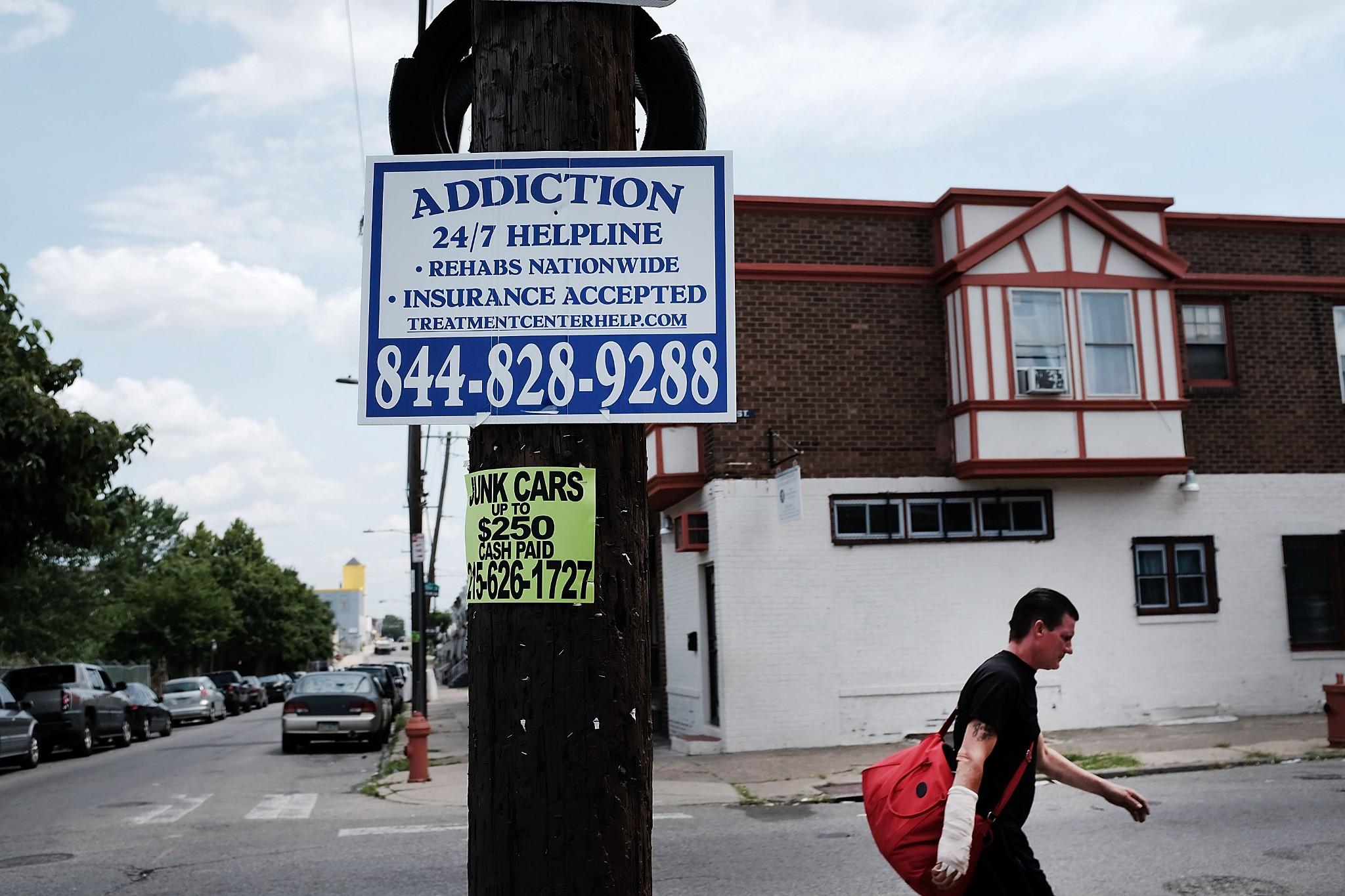To End the Opioid Crisis, Skip the Handcuffs and Rethink Health Insurance, Report Says
A new report from The Sentencing Project offers a blueprint for putting an end to a deadly epidemic.

On Tuesday, Louisiana Attorney General Jeff Landry gathered with law enforcement officials from across the state and country to train police and prosecutors how to crack down on the opioid epidemic in his state. Louisiana is one of more than 30 states that has requested this training from the National Attorneys General Training and Research Institute (NAGTRI), the Associated Press reported. Louisiana sheriffs, chiefs of police, and District Attorneys in attendance discussed tactics and tools for investigating and prosecuting cases related to overdose deaths.
“We’re trying to fight this fight collectively,” Joanne Thomka of NAGTRI told the AP.
As in many places across the country, Louisianans have watched opioid-related overdose death rates rise in their communities, and they are eager for a solution. But according to a report released today from The Sentencing Project, a D.C.-based nonprofit research and advocacy organization, Landry’s approach won’t solve this crisis. Opioids: Treating an Illness, Ending a Warposits that not only will a criminal justice response to drug addiction fail to stem the use of opioids, but that the current state of American healthcare is slowing down an effective response to the epidemic.
“Any serious discussion about ending the opioid crisis must prioritize addressing the limitations of the U.S. healthcare system,” Nazgol Ghandnoosh, the report’s coauthor, told In Justice Today by email.
The report documents how the crisis has grown, and situates the opioid emergency within the broader context of past and current health and criminal justice policies, particularly the war on drugs. It points a finger squarely at healthcare insurers that restrict coverage of mental health care, addiction treatment, and “less addictive, non-opioid medications and non-drug treatments, such as physical therapy.”
Insurers place lower-risk pain relief medications in a coverage tier that makes them more expensive than opioids, which are widely understood to pose a higher risk of dependence. Similar roadblocks to less-addictive painkillers exist in Medicare and Medicaid programs. These restrictions contributed to the increase in overdose deaths involving prescription opioids, according to the report. Such deaths have increased from 1.3 per 100,000 people in 1999 to 4.9 deaths per 100,000 people in 2015.
Some advocates and lawmakers argue that limiting opioid prescriptions will increase overdose-related deaths by pushing people with opioid use disorder toward heroin or other synthetic, unregulated drugs. While the report does recommend curbing opioid prescriptions, it notes that state and federal efforts to do so have only achieved “modest” success in stemming the growth of overdose deaths.
Ghandnoosh says focusing on overprescription “misses the big picture … and fails to diagnose that it’s a lack of access to drug treatment that makes limiting [prescriptions] harmful.” While insurance companies make non-opioid painkillers less accessible, those without insurance often lack access to medication-assisted treatment. The lack of access hits low-income Americans the hardest, according to Richard Frank, Professor of Health Economics at Harvard Medical School. Frank’s analysis of the 2015 National Survey on Drug Use and Health found that, among U.S. residents aged 18 to 64, those with incomes below the federal poverty level were 47% more likely to have an opioid use disorder than those with incomes above 200%. This same demographic is less likely to have health insurance coverage.
The “treatment gap” described by the report is also a growing concern in prisons and jails. The rate of drug use among incarcerated people is 10 times that of the general population, according to the Bureau of Justice Statistics. As a growing number of opioid users wind up behind bars, opioid detox-related deaths are increasing. A recent investigation by Oregon-based KOIN 6 reporters notes a rise in heroin-related detox deaths in county jails, sparking numerous lawsuits. To make matters worse, incarcerated people suffering from substance use disorders are often unable to access effective treatment programs. The Sentencing Project observes that the U.S. Bureau of Prisons doesn’t currently have an established medication-assisted treatment program in its prisons.
“Jails and prisons are not the place to deliver drug treatment, but if we’re going to lock up people with substance use disorder, then we better be sure to provide them with effective forms of drug treatment,” says Ghandnoosh.
So, what can be done about this complex crisis? For one, Ghandnoosh and coauthor Casey Anderson recommend abandoning the drug war. They point out that the “aggressive law enforcement” approach to crack and heroin use of the past 30 years offers a clear blueprint for what not to do. Not only did these policies fail to curb the drugs’ use, the report argues, they contributed to the current massive prison population that states are now struggling to reduce.
Unfortunately, state and county lawmakers and prosecutors do not seem inclined to learn from past mistakes. Many are increasing criminal penalties in an attempt to drive down opioid use and overdose deaths. The report documents opioid-related legislation that has emerged over the last three years in Florida, Maryland, Massachusetts, Kentucky, and Louisiana. In each of these states, bills that increase sentences or permit prosecutors to charge people who sell opioids to someone who dies from an overdose with homicide have passed or are pending.
The report’s authors also suggest curbing opioid prescriptions and increasing access to treatment in and out of prisons and jails. Reducing the number of drug-related arrests and introducing drug sentencing reforms, they say, is key to stemming the tide of opioid-use disorders and overdose deaths. Finally, they recommend expanding access to, and training for, harm reduction tools, such as naloxone, to “individuals with substance use disorder and those around them, first responders, police officers, and pharmacies.”
